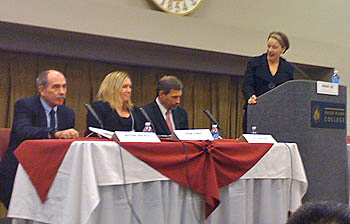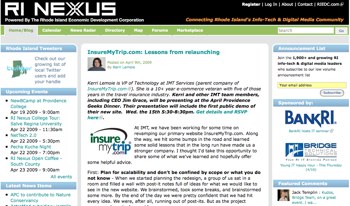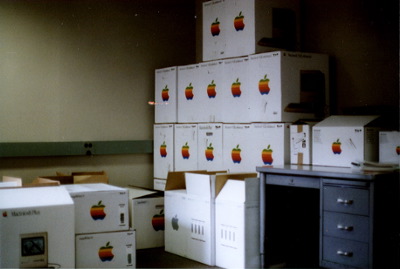Educators ponder tech innovation in Rhode Island
By John McDaid | Saturday, 11 February 2012 |
| Comm. Gist introduces (l-r) Gov. Bob Wise, Allison Powell, Tom Vander Ark |
More than 300 teachers, administrators, and education professionals met at Rhode Island College today for the first-ever "Innovation Powered by Technology (IPT) conference, convened by the RI Dept. of Education (RIDE). Attendees from across the state spent six hours hearing from nationally recognized experts, doing deep-dive breakouts, and networking with counterparts from other districts.
One of the goals of the conference was to jumpstart participants' creative thinking as they gear up for a newly announced RIDE IPT Model School Grant program, which will award $470K to a district to redesign a school by leveraging technology.
Commissioner Deborah Gist, who convened the conference, urged the attendees to think big as she kicked off the day. "Try to imagine what schools will look like in just a few years," she said. "I sometimes marvel at sitting and doing [videochats] with my sister and think, 'this is something that only used to happen on The Jetsons'. Imagine what's possible."
In what became something of a running metaphor throughout the day, Gist recounted an anecdote about a very bumpy plane flight where the pilot announced to the passengers that they were experiencing "constructive turbulence" — so called because the tail wind was going to bring them to their destination sooner.
It was a theme picked up by one of the first panelists as they sketched a big picture of the future. "On the way, it's a white-knuckle ride," said Bob Wise, former governor of West Virginia and president of the Alliance for Excellent Education, adding that the only certain thing was that "each classroom in each school will look different."
One thing that Allison Powell, VP of State and District Services at the International Association for K-12 Online Learning (iNACOL) was certain of is that teachers are not going away. "I envision classrooms where kids all have technology, and are able to work at their own pace," she said, adding, "Face-to-face interaction is important; the teacher is key to all this."
Tom Vander Ark, author of Getting Smart, urged attendees to consider the future as a lot closer than might be imagined. "You need to plan today," he said. With prices dropping and the rest of the world leapfrogging America, "You're going to see countries like the Philippines that will flip to tablets. You're going to see whole countries running their education on sub-$100 tabs."
Wise agreed. "The main misconception is that you have a choice. We can't do the same thing any more."
With that burning platform for change established, the second panel tackled options for creative restructuring of schools.
It was all about personalization for Michael Horn, Executive Director of Education at Innosight Institute, co-author of Disrupting Class: How Disruptive Innovation Will Change the Way the World Learns. "It should be a very intentional shift to personalizing learning for what each student needs." And, he added, "It should be exactly the steps to reach those children who are having the most issues."
Jeff Mao, the learning policy director at the Maine Dept. of Ed talked about the importance of breaking out of our current concepts of the school house. "We need to get beyond Adult Paradigm Paralysis — APP — and leadership is what really makes these things move. It's not a technology program, it's a learning program."
Anthony Kim, founder of Education Elements stressed design thinking. "It's an iterative process, and you need to start by thinking about the end state," he said. "It takes time to get there. You can't expect everyone to be there on day one."
The panelists offered their specific advice to districts approaching the tech grant process. "There are some good models out there. Look at what's going on in other schools, but don't be constrained," said Horn. "If you can't get to 1:1 [ratio of device to student], find some ways to leverage." For Mao, the pre-work was critical. "Build a shared vision across constituencies of where you're going and why," he said. "Make sure you start with solutions and educational goals, and don't start with the hardware." Kim also spotlighted working backward from goals. "Think about what you're preparing students for: college." He suggested designing the kind of school that would provide preparation. "Create that kind of environment."
After the two morning panels, the attendees broke into small topic-focused groups. In Jeff Mao's "Access to Technology," participants peppered Mao with questions about bandwidth, security, and hardware selection. One key takeaway for me was Mao's insight about device multiplication. "It's not if you're going to 1:1, it's when," he said, "But then, you have to start thinking about 2:1 and 3:1." Kids are walking around with phones and iPods, he noted, and it's better to leverage than ignore them.
In the second pre-lunch group, Allison Powell talked about communication, and fielded a series of questions about the best way to engage all stakeholders — including the sometimes-fearful staff members. "You need buy in from everyone," she said, stressing the need to involve groups like guidance counselors, paraprofessionals, and especially the tech guys. "But don't let them dictate," she said.
The group had a working lunch — pasta and salad — as they sat around tables color-coded for "birds of a feather" discussion topics. Then it was time for a series of deep-dive breakouts.
Portsmouth resident Dave Fontaine ran a session on open educational resources, higlighting the free, open-source options available for schools. Two wonderful resources he demonstrated were CK-12 and Curriki.
CK-12 offers "Flexbooks," a free library of peer-reviewed STEM textbooks which can be printed, PDFd, or read online, with many downloadable in a variety of e-reader formats. What makes them "Flex" books is the cool web interface that allows registered users, with just a few clicks, to mix and match chapters to assemble a customized package (Imagine a customized physics text that had a chapter or two of calculus built right in.)
Curriki (a portmanteau of "curriculum" and "wiki") offers educators a read-write environment where they can upload, revise, share, and rate curricular materials, with a search engine that allows educators to filter the collection by grade and subject. And just by signing up, educators can upload and share their materials. "Imagine common plannign time or professional development spent doing open-source curriculum development," said Fontaine. "What we educators have been doing for years is giving away our knowledge. This just adds a tech twist."
In the second session, Tom Vander Ark engaged a small group of attendees in a discussion of the possibilities and challenges of tech innovation. The technologies ranged from simple games and simulations — like those at PhET — to the thick descriptions available to teachers from a student's day-long interactions with "learning objects."
"Think about how much Google knows about you, and compare that to how much we know about our kids," said Vander Ark. "The shift to big data, when we can capture and mine keystroke data and mine that for individual learning patterns will enable customized learning driven by 'smart' learner profiles." He cited New York's School of One as a possible adaptive curriculum model, where students arrive in the morning and find their schedule for the day on LED signboards. Students rotate through six different centers, with their specific experiences programmed by data-driven analysis to meet their needs for that particular day. Imagine a small group with a teacher, said Vander Ark, where the algorithm has determined, "That's the right mode, the right day, with the students prepared for that lesson. That's magic. Smart tools that get teachers and kids together at the right time."
The wide-ranging discussion did not minimize the challenges. The perpetual arms race with cheating, the question of print literacy vs. the digital, and the challenge of local control all came up. And the grip of the local can be hard to shake, said Vander Ark, "But, come September, shame on you if every student in Rhode Island doesn't have access to every AP course and every language. Technologically, you can do that."
And a bit further out, there is the emerging challenge of comparability. When students take many individualized paths to mastery, how can these be aligned so that teachers and administrators can confidently assess progress. "Right now we don't have a good way to compare the results of diferent assessments," said Vander Ark. But he suggested that big data pointed the way. "This is something we're going to have to invent around the Common Core -- how different systems translate. We need a kind of Lexile scale, so that if a kid is in 12 different apps during the day, we can make sense of of it when it lands in the grade book."
The attendees reassembled for a final comment from Commissioner Gist, who acknowledged that the agenda was still very conference-like, and promised that this was only the first iteration of RIDE's vision. "We have big plans for how we move this forward, including future gatherings like this, using technology." After a raffle of door prizes (including a Middletown HS junior who took home an iPad!) the event concluded shortly after 3pm.
You can review the real-time conference Twitter feed here.
Editorial note: Long-time readers will know that I have differed with the Commissioner in the past on issues of funding, but when it comes to technology in our schools, I believe we are in alignment. We had a very nice chat after the conference, and I thanked her for organizing this event, and for her leadership. I think this is critical for our schools and our kids. Thanks to Comm. Gist, organizer Holly Walsh, all the folks at RIDE who worked to make the conference happen, and the hundreds of educators from around the state who gave up their Saturday to push this forward.
 RI Nexus, the RIEDC-sponsored hub for the the IT and digital media (ITDM) community, will be coming to Salve Regina on Wednesday, April 22 at 11:30am as part of their college tour.
RI Nexus, the RIEDC-sponsored hub for the the IT and digital media (ITDM) community, will be coming to Salve Regina on Wednesday, April 22 at 11:30am as part of their college tour.  Just in case you're wondering, no, the entire Internet has not been infected, Google's alarming notice in search results notwithstanding.
Just in case you're wondering, no, the entire Internet has not been infected, Google's alarming notice in search results notwithstanding.